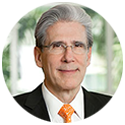Health Professions at the Crossroads:
Building a Better Normal
 Presenter: Julio Frenk, MD, MPH, PhD, President, University of Miami
Presenter: Julio Frenk, MD, MPH, PhD, President, University of Miami
Reported by: Robert D’Antuono, MHA
“We are facing a unique moment in time”, began Dr. Julio Frenk, the distinguished keynote speaker at the SACME 2021 Annual Meeting. “As a result of COVID-19 we are experiencing what has been termed as the ‘Fauci Effect’, that is, an increased interest by students wanting to go into the health professions,” he continued. We are at a threshold of a revolution in education. A distinguished physician, epidemiologist, academic and government leader (Minister of Health of Mexico, 2000 to 2006), and the lead author of the Lancet report Health Professionals for a New Century (Frenk et al., 2010), Dr. Frenk presented a compelling keynote address on how technology, learning science, and the transformation of the healthcare labor market will shape the future of health education and CME/CPD.
Dr. Frenk cited two mega trends which have emerged from the present pandemic: COVID-19 has become an accelerator of change in the health professions and health education in particular, and the strong interest in ‘building a better normal’. We should think about building a better normal and to learn lessons from this pandemic. As this is the 10th anniversary of the Lancet report, it’s appropriate to revisit the changes needed to transform education in the health professions. There are three fundamental drivers of change that are clearly charting our road to the future: first, advances in learning sciences (how humans learn); which has resulted in the second driver, i.e. the unprecedented advances in technology (the online environment), and third, changes to the labor market driven by new professions being created from advances in technology.
In the 2010 Lancet report, two dimensions of a new strategy for change were discussed: the instructional change and the institutional change. The instructional dimension strategy poses some key questions about instruction, strategic shifts, educational redesign principles, and the need for continuous leadership development. The key questions are: what to teach ( the curriculum); how to teach (mode of delivery); when to teach (target portion of the life cycle); and whom to teach (access and diversity). The strategic shifts include moving from a closed instructional system to an open architecture; from a standardized experience to a responsiveness to diverse needs; and lastly from a front-loaded education to an education for life.
To make these strategic shifts, we must embrace five educational redesign principles. The first is to offer a broad foundational knowledge that every graduate must achieve, along with cross-common competencies in critical thinking, ethical reasoning, communications (oral, written, visual), team work, and learning how to appreciate contrasting perspectives.
The second redesign principle is to make education interdisciplinary and to assure a team approach. Third is a move into ‘engaged learning’ which is active, interactive among a community of learners, and personalized. Fourth, a blended-learning format which is transformative, formative and informative. Lastly, and most critical, we must strive to offer an integrated learning experience of online, onsite and in the field. Throughout this new instructional strategy is leadership and continuous professional development opportunities for new and current leaders to move through the stages of leadership growth from the emerging to the mature leader.
The second dimension of a new strategy is institutional reform. Three changes are necessary: Faculty resistance to change among colleagues must be eliminated making faculty development an imperative. Our capacity must change and become more flexible, incorporate the use open learning spaces, and embrace more interactive technology. Third, a culture of assessment and peer review which links outcomes to interventions in education must become the norm. It is understood too that throughout this change process, we must recruit and retain minority faculty and students, and embrace diversity, equity and inclusion principles to higher education otherwise we will fail in our social mission.
Building a new normal is likely to become the operational mantra of SACME members for at least the foreseeable future. Dr. Frenk ended with a poignant quote from Albert Einstein: “You can’t solve a problem on the same level that it was created. You have to rise above it to the next level.”